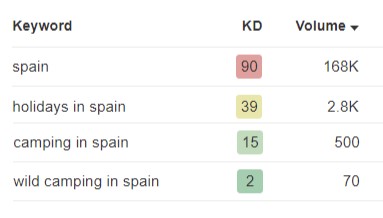
How to do keyword research
Search Engine Optimisation is about ranking in search results when people are searching for your product or service. To do so, you need to optimise your site for specific topics and keywords that are relevant to your business.
While it may seem a bit of a daunting process, it is essentially information gathering, and about the topic that you are in business in, so you’re already an expert! Keyword research is about finding the right topics that will connect your expertise (and website) with your desired audience.
In this article:
- How to do keyword research
- How to pick the right keywords
- Mapping keywords to your site
This article is part of the Get Started Hub, the starting point for SMEs & sole traders’ SEO and content journey. Find more information in the hub, or get in touch with me to find out how I can support your business.
How to do keyword research
Keyword research is about finding the relevant keywords to your business that people are actively searching for. Targeting keywords that nobody is using will not bring in any traffic, and only optimising for very generic keywords will make it hard to rank, as they’re so competitive. There are a range of free keyword research tools available, in this article, we’ll focus on how to use them.
Understanding your keyword volume and difficulty
To research if a keyword is popular and searched for, type the keyword into your chosen tool. The tool will give information on how often the term is used (often called search volume), and how competitive or difficult the keyword is to rank for.
Generic keywords are more top-level and straightforward keywords, such as “dress”, “tennis”, or “Spain”. These keywords will often have a high search volume, but they are also difficult to rank for, as they are so broad. It’s therefore important to consider what keywords actually are relevant to your business.

Consider long-tail keywords
A travel agency doesn’t want to rank for “Spain”, as those results are more informative about the county, and not relevant to the travel business. “holidays in Spain” or “city breaks in Spain” would be much more suitable, but can still be very competitive.
However, a travel agency specialising in camping and self-driven touring trips through Spain can dig even further with “two-week camping trips Spain” or “self-driven camping tours Spain”. There will be less search volume, but the audience searching these terms are looking exactly for what the specialised company offers.
These longer keywords and keyword phrases are (unsurprisingly!) called long-tail keywords. They will be more specific and have less search volume, but the intent behind the search is a lot higher. Users who drill down their search into long-tail keywords are more aware of what exactly they are looking for – and you can meet their needs by targeting relevant keyword phrases.
Find synonyms of your keyword and related keywords
When doing research, don’t just stop at your main keyword and call it a day. Look into synonyms, or less often used namings for your products or services, and understand how they perform.
You may always call your product by the same name, but the general public might have a completely different name for it. So dig a little deeper and look for alternatives to understand what matches your ideal audience the most.
An example I’ve had with a previous brand I worked with was the difference between rucksack and backpack. While they both are the same product, the term rucksack is more associated with the outdoors, while backpack was used when talking about school. When targeting outdoor gear I had to be sure I wasn’t using backpacks, as the results wouldn’t have been relevant for backpack searches, and I’d miss out on people looking for camping rucksacks!

How to pick the right keywords
You’ve looked at your generic keywords, long-tail keywords, alternatives and synonyms, and you have all the data gathered. Now you need to start making decisions on which keywords to target.
Pick relevant keywords
First and foremost you have to keep in mind relevance. Is this keyword relevant to your product and services? Is it relevant to your audience? When you get more into long-tail keywords the phrases become more specific: are you sure your content is the answer to this question, or part of this topic?
Second is the keyword volume and difficulty. While long-tail keywords are high on intent, if the volume is too little you will not get much traffic from it. A good mix of different keyword volumes helps. If you start with content marketing the best way to cover this is to create topic hubs, where you start generic and get more in-depth with every article until you have covered it completely.
One thing to keep in mind is that if you optimise for “Red Dresses” you technically also optimise for the more generic dresses. There’s no need to add “Red Dresses, Dresses, Dress” to your meta tags, as that would be considered keyword stuffing.
Keep it relevant, and if your content doesn’t match the query at the moment, consider writing new content that does, and use the keyword with this new piece of content.
Look at the results for your keyword
Look up your keywords in search, and see what content is ranking. They’re competing with you for that organic traffic, so it’s important to check them out!
When you look at the results, keep an eye out for a few things:
- What kind of sites are ranking? Are they official government or educational websites? Are they blogs? Is there more than one type of website here?
- Are there any videos or images ranking in the results?
- How long are the pieces of content that are ranking highly? Can you create something similar or better than them?
- Are any keywords included in the title tags and URLs of posts that rank highly for this query?
If you sell products, but the search engine results page (SERP) only shows informative pages, then the search engine only wants informative content here – you’re not likely to rank with a product page here.
Have a look at the results, and how relevant they are to what you can offer. If you can match that, great! If you can’t, is it worth creating content that does, or are you better off with different keywords to target?
See what kind of blog posts are ranking for your keyword
If you are doing keyword research for content marketing, have a good look at what content is already available for these keywords. How long is the content? What kind of content is it, are they image-heavy or supported by video?
What keywords are your competitors using, and are you missing out on any good ones? Consider adding them to your keyword research to find out if they could be of use to you too.
Long-tail keywords come into play here again as well. Once you start your content marketing with a topic, you should target long-tail phrases relevant to your topic. Linking these together will help your overall performance on this topic over time.
Mapping keywords to your site
Now that you have chosen your keywords, you need to map them to your website. Whether you already have a website that you are now optimising, or starting from scratch, this is an important step.
Ideally, you optimise each page for 1-3 related keywords, and you don’t optimise multiple pages for the same keyword. Targeting the same keyword on more than one page means you are confusing search engines and “diluting” the keyword. This is referred to as cannibalisation, where instead of competing with others in the SERPs, you are eating away at your own keyword strength.
Creating a map that organises which page targets what keyword will help you avoid this. It will also help keep an overview of what you are already targeting, and later on which pages don’t seem to perform as well and could use a bit more attention.
Getting started with keyword research really is the beginning of improving your organic traffic. Now that you know how to find the right keywords to target, read more about the free keyword research tools you can use and how to optimise your pages for your chosen keywords.
This article is part of the Get Started hub. Learn more about SEO and content, or get in touch to find out how I can support your business.
